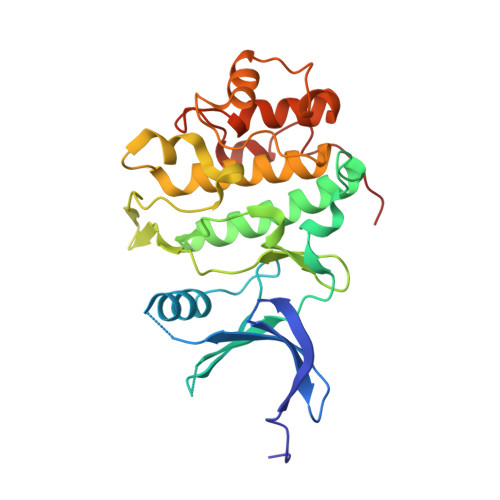Characterization of the CHK1 allosteric inhibitor binding site.
Vanderpool, D., Johnson, T.O., Ping, C., Bergqvist, S., Alton, G., Phonephaly, S., Rui, E., Luo, C., Deng, Y.L., Grant, S., Quenzer, T., Margosiak, S., Register, J., Brown, E., Ermolieff, J.(2009) Biochemistry 48: 9823-9830
- PubMed: 19743875
- DOI: https://doi.org/10.1021/bi900258v
- Primary Citation of Related Structures:
3JVR, 3JVS - PubMed Abstract:
Checkpoint kinase 1 (CHK1) is a key element in the DNA damage response pathway and plays a crucial role in the S-G(2)-phase checkpoint. Inhibiting CHK1 is a therapeutic strategy involving abrogation of the G2/M mitotic checkpoint defense of tumor cells toward lethal damage induced by DNA-directed chemotherapeutic agents. To date, most CHK1 inhibition approaches have involved targeting the ATP site of this kinase. In this study, we provide crystallographic and kinetic characterization of two small molecule inhibitors that bind to an allosteric site in the proximity of the CHK1 substrate site. Analysis of kinetic and biophysical data has led to the conclusion that these small molecule allosteric site inhibitors of CHK1 are reversible and are neither ATP- nor peptide substrate-competitive. K(i) values of 1.89 and 0.15 microM, respectively, have been determined for these compounds using a mixed inhibitor kinetic analysis. Cocrystal structures of the inhibitors bound to CHK1 reveal an allosteric site, unique to CHK1, located in the C-terminal domain and consisting of a shallow groove linked to a small hydrophobic pocket. The pocket displays induced fit characteristics in the presence of the two inhibitors. These findings establish the potential for the development of highly selective CHK1 inhibitors.
Organizational Affiliation:
Department of Biochemistry and Primary Screening, Pfizer, La Jolla, San Diego 92121, USA.















